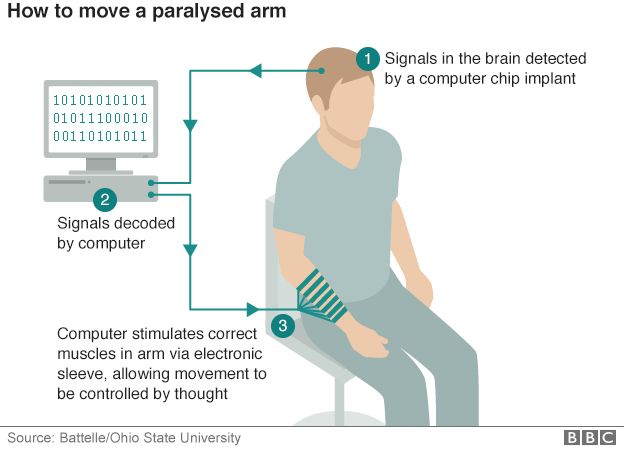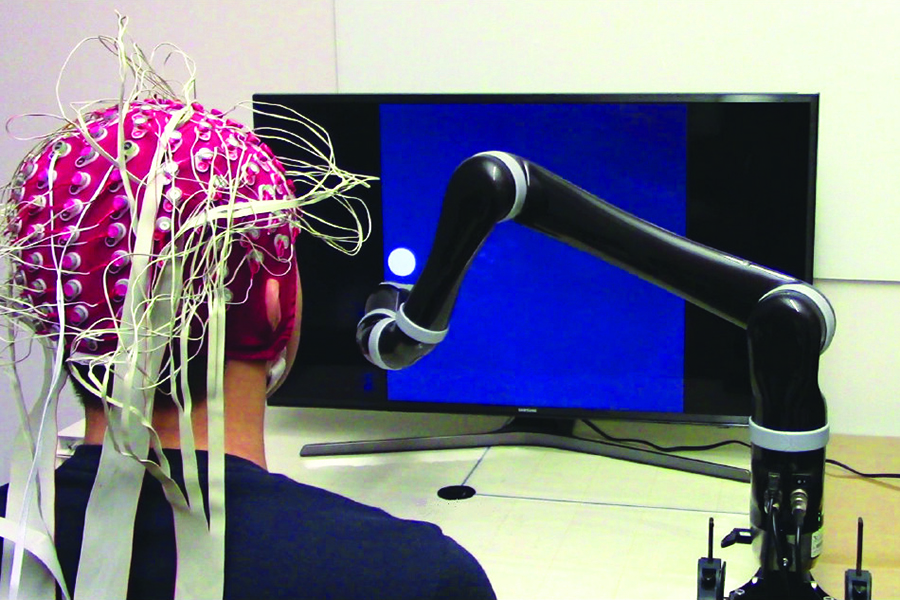Neuroscience and Machine Learning Restore Movement in Paralyzed Man’s Hand
Last week, the New York Times reported the first successful “limb reanimation” in a person with quadriplegia. Ian Burkhart, 24, had broken his neck as a teen in a diving accident. His spine was damaged at the fifth cervical vertebra, leaving him paralyzed from the shoulders down. Using nerve bypass technology that transmits his thoughts directly to his hand muscles, he has regained control over his right hand and fingers.
The system effectively bypasses his spinal injury. This is the first time a brain-computer interface has been used to help an individual move his own hands. The research was published in in the journal Nature, and explains how machine learning and MATLAB were used in this project.
This remarkable breakthrough is the result of years of research and a cross-discipline project. Engineers, bioengineers, neuroscientists, and surgeons contributed to the prototype medical system and clinical study. The device, called NeuroLife, was invented at Battelle Institute. The engineers at Battelle worked with physicians and neuroscientists from Ohio State University Wexner Medical Center to develop the research approach and perform the clinical study.
In 2014, Ohio State surgeons implanted a chip in Ian’s brain. The Utah Array chip from Blackrock Microsystems consists of 96 microelectrode sensors that record the firing of individual neurons. The team used brain imaging to identify and isolate the part of Mr. Burkhart’s brain that controls hand movements. During the surgery, the team repeatedly tested exposed brain tissue to pinpoint the correct location for the chip.
After the surgery, Mr. Burkhart spent hours upon hours watching an avatar of a hand on a screen, concentrating on the thoughts it would take to make the movement. During these sessions, the activity in his brain was recorded and analyzed. The goal was to understand which signals in his brain corresponded with the hand movements he was mentally emulating.
The firing patterns in his brain were transmitted to a computer and recorded. The amount of data this requires is immense. Three million samples of neural activity are collected each second. Approximately one gigabyte of data is generated from neurons in the motor cortex every three minutes.
The researchers used machine learning to decode these patterns. Through repetition, the firing patterns were analyzed and used to develop an algorithm to control the muscles in his hand. The algorithm was adjusted after almost every training session. Machine learning aided the recalibration as Ian’s mind adjusted to the movement and apparatus.
How MATLAB was used in this project
From the journal Nature:
“The digitized data were then transmitted to a personal computer where they were decoded to determine which motion was being imagined and then encoded to evoke the desired response from the muscles in the forearm. The computer communicated with the custom high-definition neuromuscular electrical stimulator (NMES) that drove the electrode sleeve wrapped around the forearm.
“The signal processing and decoding/control algorithms were all run on a personal computer using MATLAB. The digitized data from the Neuroport was processed every 100 ms.”
The computer decoded the signals from the brain and translated them to specific movements. The team used a NMES sleeve that applied electrical stimulus to his hand muscles. The sleeve has 130 electrodes that rest on the skin’s surface and transmit signals through Ian’s arm to activate his muscles.
After a year of training, Ian was able to learn through repetition to pour from a bottle, and stir a cup. He was also able to learn to play a guitar video game!
More work is needed
- For starters, the system isn’t portable. The Neuroport requires a direct connection to the computer. Additionally, the amount of data produced exceeds current wireless capabilities. To truly enhance independence, a wireless system will be required.
- There are also limits to the movements that can be accomplished. The implant only monitors up to 96 of the millions of neurons in the motor cortex. For complex hand movements, people use far more than a hundred neurons. In future studies, the team plans to increase number of electrodes.
- The sleeve that transmits electrical pulses to stimulate the muscles in the forearm will likely need to be adjusted as well. The current voltage levels required to transmit through the skin can interfere with the signals being recorded in the brain. In the future, researchers may implant the electrodes in the forearm in order to reduce the voltage used.
As amazing as the technology is, I have to say that I am equally amazed by the brave man that was willing to dedicate so much of his time and effort in an attempt to further the research and help others. Mr. Burkhart agreed to go through multiple brain surgeries even though he knew the reclaimed mobility would only be temporary. The system only works while he’s at the lab and the chip will be removed later this summer. The hope is to create a system that will be able to help people like Ian gain independence in their everyday life.
“…even if it’s something I can never take home in my lifetime, I’m glad I’ve had the opportunity to take part in this study… I know that I’ve done a lot of work to help other people as well,” Ian Burkhart said in his interview with Nature.
Kudos, Ian.









Comments
To leave a comment, please click here to sign in to your MathWorks Account or create a new one.